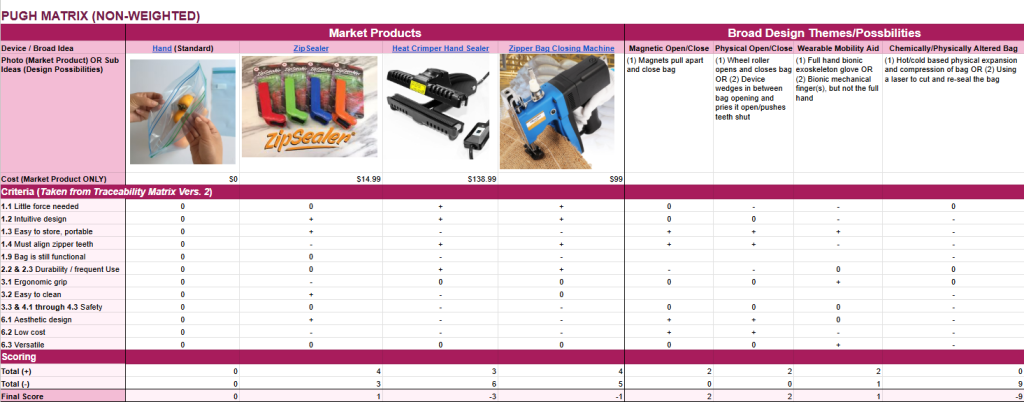
Brainstorming Process
Idea & Brainstorm: 1st Idea
Device: Assistive tool/device to help open pasta jar lids
Brainstorm:

- Manual lid remover: Device allowing one to grip the lid of a jar, apply torque (using upper arm joints not affected by arthritis, ex: wrists and elbow), and twist open.
- Countertop devices: A machine that sits on the counter, allows you to place the entire container/jar in it and holds it in place, then mechanically twists the lid off.
- Motorized tools: A tool that sticks/suctions onto only the lid of the jar and automatically twists it off.
- Hand wearable: wearable device that goes over either the thumb and forefinger OR the whole hand and applies force and pressure when needed.





Idea & Brainstorm: 2nd (Final) Idea
Device: Assistive device to help open and close resealable bags
Brainstorm:

- Motorized unzipper: device placed over opening of closed bag, mechanically unzips bag using a small motor or electronic.
- Wedging and prying device: wedges between top lips of bag, exerts outward force to open.
- Handheld magnets: uses opposing magnets to pull the bag apart and stick the top of it back together.
- Roller: bag placed between rollers, rolling motion either pulls sides of bag apart or presses them back together.
- Hand/finger wearable: goes over two fingers or whole hand, has some sort of suction, pincher, or magnet to grab onto bag sides and open or close.
- Physics-related: use of lasers or heating/cooling applied to the bag via some kind of electronics.
Pugh Matrices
To decide on a design concept we wanted to pursue, we made two Pugh Matrices with criteria that were defined in our Traceability Matrix.
Our first Pugh Matrix was unweighted. In this matrix, we evaluated 3 currently existing market products against a standard (which we determined was just opening a resealable bag with your hands). These three products were the ZipSealer, a heat-based bag crimper/sealer, and a zipper bag closing machine that operates similar to a sewing machine. We did this to determine which product was the “industry standard” we should compare our potential design options to. In our evaluation, we decided that the ZipSealer would be our standard, since it was the only product that had a positive score.

The second Pugh Matrix we made was weighted. In this matrix, our criteria was weighted from 1 to 3, with 1 indicating less important criteria and 3 indicating more important criteria. Each design concept was rated on a scale of 1 through 5, where 3 meant the product was comparable to the Zip Sealer. Anything 2 or below meant the concept was worse, whereas anything 4 or above meant the concept was better in that criteria. The scores from 1 to 5 were multiplied by the weight of the criteria, and these values were summed across all 12 criteria.


At the end of this process, we identified the top 3 potential concepts to move forward with. These are (in order of lowest scoring to highest scoring): a slide-across device with a magnetic open/close mechanism (with 91 points), a reusable automatic slider tab that is similar to a Ziploc® tab (with 93 points), and a partial hand exoskeleton device (with 95 points).
